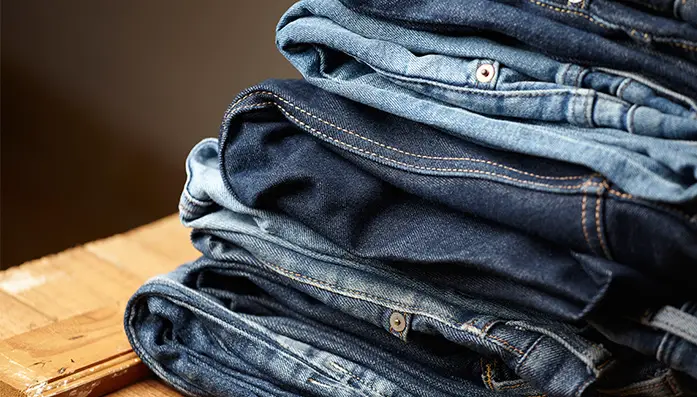A pair of jeans is available in every person’s wardrobe, and still, a lot of us don’t know what really they are made of. Though it is not that necessary to know what fabric is used to make jeans unless you are experimenting with your Jean, like drying in a drier, bleaching, etc. Besides that, there is always curiosity among people to know what are jeans made of. And to put end to this question, today I will provide information on the fabrics used to make jeans and why they are used.
What are jeans made of?
Mostly, high-quality jeans like Levis 511 or American eagle jeans are made of cotton fabric using twill weave to provide comfort, Breathability, and durability to the jeans. Twill is woven and has diagonal ribbing along with it.
Though the use of cotton in jeans totally depends on the manufacturing. Some companies blend other fabrics with cotton to make jeans, which will be further discussed in the article.
Making denim is a complex process and takes a lot of time. From harvesting cotton to dieting and then to weaving. Overall, in the end, you get strong denim that is tough enough to survive years and years of torcher.
Though most premium quality jeans today are made of 99 % percent or 100%cotton, however over the years many other different fibers are used to make jeans.
Cotton
Cotton is the supreme fabric used to make jeans. It is the softest and most versatile fabric with a lot of pros.
The reason to choose cotton in jeans is to make them durable and comfortable.
Twill
Twill weave is used in different patterns in different jeans. Most often twill creates a diagonal pattern.
Jeans that have a diagonal twill pattern that is, a twill line runs from one side to the other. The most common twill weave used in denim is 3*1 and 2*1. However, the best quality weave is a 3*1 weave.
Raw denim or jeans
Raw denim is the most durable jeans as it is not washed at any stage of the denim journey, even after the dying stage. Further, no treatment is done after the dyeing stage.
The reason why it is called raw is that it is stiff to wear as it is not washed. However, when, you first wash it, it can shrink the most because it is not prewashed.
It is recommended that you should wash raw jeans before wearing it, to make the fabric softer and more comfortable against the skin.
The best part about raw jeans is that they look tough and rugged without any distressing. The natural distress come in jeans with time after many washes which looks more appealing.
Lycra, spandex and elastane
Jeans or denim made of blends of these fabrics is known as stretch denim. The reason why these jeans are called stretch denim is that they have stretch in them because of elastic fibers like elastane.
The amount of elastane used in jeans is what decides the Stretchability of jeans. Mostly, high-quality jeans are made of cotton and elastane blend to provide some stretch to the jeans. The amount of elastane wary in different types of jeans.
The percentage of elastane is more in skinny jeans as compared to relaxed, loose-fitted, or mom jeans. Normal slim-cut to loose jeans have 1 to 3 percent of elastane in them. The number is the same or higher in skinny jeans.
Polycotton
Polycotton jeans are very common in the market. Most companies use polyester to cut down the cost as polyester is a synthetic fabric and is cheap.
However, polyester alone is not used to make jeans but is used as a blended fabric to provide some strength to the jeans. Polycotton jeans are not always cheap, especially if the percentage of cotton is more than 60 percent. These types of jeans are easy to care for and cost way less than most premium jeans.
Caturday
It is a thick cotton fabric that is used to make jeans like lee jeans. It is made from different fibers and used to provide durability to the denim.
Sanforized jeans
This basically is raw denim but will not shrink like raw denim. The treatment is done in advance to prevent shrinkage in jeans.
Raw denim is famous for its rough and tough look among jeans lovers. But the only problem with them is that they shrink, but if you are buying raw denim that is sanforized, then you don’t have to worry as it is already pre-shrunk. These types of jeans are often called preshrunk jeans. And to find out if the jeans are preshrunk Or not, one has to check on the label of the jeans.
How jeans are made using different fabrics?
There are a variety of different fabrics that companies use to make jeans. The making of jeans is not an easy process as jeans go through various different stages until it get shipped to warehouses for sale.
Though most companies use a similar process to make jeans, however, there are some companies like beloved Levis, which use a different method to make jeans.
To make jeans cotton goes through several stages. Firstly, cotton is harvested from the fields and then it cotton is separated from the seeds. Further, yarn is made which later goes through the dyeing stage, and finally, the dyed yarn is treated where chemicals are applied to prevent the shrinkage in jeans. This process(treatment) is missing in raw jeans.
First stage
In the first stage cotton from seeds is converted into yarn. Most denim (jeans fabric) is made of cotton. Some high-quality jeans use 99 percent of cotton nowadays with 1 percent of spandex Or Elastane. Both elastane and spandex are used in low percentages to provide some stretch to the jeans.
The maximum number of jeans has 3 percent of spandex Or Eleanste in them. About 5 percent elastane is used in other clothing items like T-shirts which makes the clothes super stretchy.
However, vintage jeans like Levi’s 501 vintage jeans does not use any other material like elastane Or spandex. The jeans made in the mid-19th century were 100 percent cotton. But speaking of the present, almost all jeans use elastane or spandex to provide some stretch in jeans like skinny jeans or slim jeans.
Dyeing stage
Dyeing is one of the most important stages to make any jeans look like denim. The jeans are not usually blue but they become after they passed through several cycles of dyeing.
Mainly there are two types of dyeing that are used by companies and i.e Indigo dyeing and sulfur.
Though both methods have been used but Indigo method is used widely by most of the prominent companies all around the world.
Indigo dyeing is the traditional method used to make blue jeans or provide blue shades to the jeans. Indigo is a dye that comes from the plant family known as the Indigofera family.
Dye is extracted from dried and fermented leaves of Indigofera tinctoria. This is a traditional method that has been followed by all the jeans makers.
Though this is a natural method, but at present most companies use synthetic indigo dye to give color to the jeans.
When jeans come to the dyeing stage, it is dipped into the solution several times with oxidation. This also decides the strength of the color. The more time it goes inside the solution, the more strong the color will be on the jeans.
Sulfur is another dyeing method that is used by companies to make different colors of jeans other than blue, which are white jeans, black jeans, etc.
Weaving, singed, and sanforization stage
Once the fabric has been dyed and prepped, it’s time to start the weaving process. This is where the denim fabric is actually created on a loom. The weaver will thread the yarns through the loom to create the desired denim weave pattern.
Common denim weave patterns include twill, satin, and plain.
After the weaving is complete, the denim fabric will then be singed. This is a process that uses a flame to melt away any loose fibers that are sticking out of the fabric. This helps to create a clean and smooth surface.
The next step is called sanforization. This is a process that shrinks the fabric so that it won’t shrink when you wash it later.
The fabric is placed in a large cylinder with steam and then rolled out. This helps to set the size of the denim so that it won’t shrink when you wear it or wash it later.
Finally, the denim fabric is ready to be cut and sewn into your new jeans!
History of denim
let’s know the history of denim.
A lot of people don’t know but denim or the jeans we love today has an interesting history behind it.
There was a tailor named Jacob W. Davis, who first made the trousers using denim fabric. The idea of using denim came to his mind after a random woman came to his shop and demanded durable and tough trousers for his husband.
After he created the first denim, they became so popular and the demand was on surged. However, due to fewer resources, it is hard for tailor to match the demand. So, that made him approach the Levi Strauss & Co. Headquarters in San Francisco USA.
Levis has seen the potential in the idea and agreed to make the denim jeans with the material that was patented by Davis. After this, Levi also made “Davis the tailor” head of mass production in their company, which was in San Francisco at that time.
After this Levi’s became the market leader as they were the first brand or company to make durable and rugged jeans for people. After that lot of Companies started copying the idea. However, it was not before the mid-19th century, those denim jeans starts becoming people’s choice. The reason for that is to create durable and strong clothes for miners, and other workers.
First denim was used to make durable clothes but the best thing about this fabric is that it is also comfortable to wear and easy to break in.
Which fabric is best for jeans
There is no doubt that jeans made of cotton are the best quality jeans out there. They are breathable, tough, and last longer. However, this doesn’t mean you should only buy 100 percent cotton jeans.
There are some downsides to wearing cotton jeans as well. As such, you don’t get a stretch in jeans. Further, you have to be more careful with the laundry process if you are buying 100 percent cotton jeans.
Besides quality, blended jeans are also durable and can be worth buying. Cotton, elastane blend jeans are best if you are looking for some stretch in the jeans. Further, poly-cotton jeans are tough and don’t demand much care.
How to find out if the jeans are quality jeans
The best way to find out if jeans are quality jeans is to check the label on the back side of the jeans. More the cotton, the more expensive and quality you get in jeans. Further, as discussed above you should not always look for 100% cotton jeans and also look for cotton blend jeans.
Another way to tell if the jeans are high quality is to check the sticking on the jeans. Zippers, pockets, and even buttons on jeans define the quality of jeans.
Is jeans material harmful to the environment?
Making jeans fall into the textile industry, and it is not a hidden fact that making jeans does harm the environment indirectly.
So, a lot of you may don’t know, but making a pair of jeans require a lot of water, around 57000 liters of water is used to make a pair of jeans. Now, if you total that up for the number of jeans produced every day then the number will blow your mind. Alone In the USA, around 300 million pairs of jeans are sold every year, which means a lot of jeans. Besides that, if we count some other nations as well then the number will be 10 times this.
The reason why this much water is required to make single pair of jeans is because of the material they are made of which is cotton. Cotton is a natural fiber that needs a ton of water.
According to some surveys, more than 70 percent of river water in Asia is polluted, which is mainly because of the textile industry.
This amount of usage of water to make jeans has impacted the rivers, and ecosystem in Asian countries like China, Bangladesh, and India ( these are the countries where maximum jeans are made). The reason behind this environmental damage is the water that goes through rivers. There is also a documentary called “The RiverBlue: Can Fashion Save the Planet?” which provides more detail on the topic.









